The Importance and Features of i1 Carat Diamonds
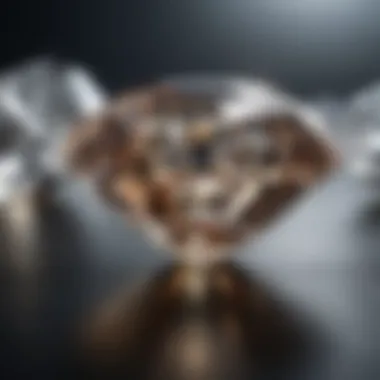
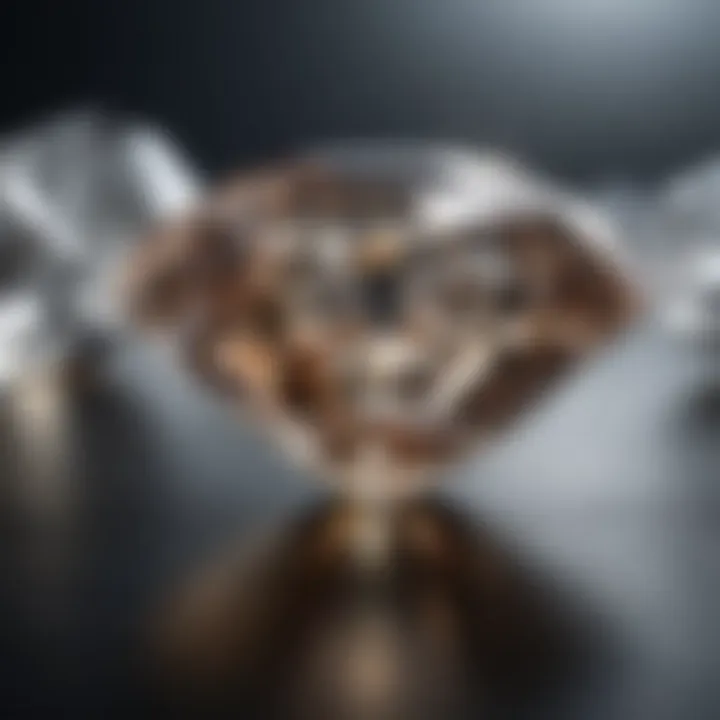
Intro
In the realm of gemstones, diamonds hold an unparalleled allure. Among them, i1 carat diamonds, often less celebrated than their higher-clarity cousins, offer a unique narrative intertwined with beauty, economics, and culture. This journey into their characteristics and significance will illuminate the multifaceted aspects of these gems. From grading intricacies to their cultural weight, understanding i1 carat diamonds can empower buyers and enthusiasts alike.
Gemstone Overview
Definition and Origins
Diamonds are more than just precious stones; they are chronicles of Earth's history. Formed deep within the Earth under immense pressure and heat over billions of years, diamonds were born from carbon atoms rearranging into a crystal lattice. An i1 carat diamond falls under the category of clarity grading, where 'i' signifies inclusions that are noticeable under magnification. Carat, on the other hand, is the metric for weight, with one carat equating to 0.2 grams.
The concept of diamonds has evolved through various civilizations. Initially, these stones were believed to possess mystical powers, often linked to strength and protection.
Historical Significance
Historically, diamonds were revered as symbols of wealth and status. In ancient Persia, they were thought to be tears of the gods, while in India, the diamond trade flourished long before it became famous in Europe. During the middle ages, diamonds were often set in armor to protect the wearer. As time progressed, their significance shifted towards romantic ideals, epitomized by the modern tradition of engagement rings. Despite the varying perceptions, i1 carat diamonds offer a more accessible entry point for many consumers, making them relevant in today's market.
Gemstone Properties
Hardness and Durability
Diamonds are renowned for their hardness on the Mohs scale, rated a perfect 10. This unparalleled durability makes them suitable for daily wear, particularly in jewelry like rings and bracelets. An i1 carat diamond will withstand considerable impact without damaging the stone, although the clarity grading suggests areas of internal inclusions or surface blemishes, which could affect aesthetics but not the gem's strength.
Color and Clarity
While color grading in diamonds ranges from clear to various shades, i1 carat diamonds tend to exhibit a more noticeable presence of flaws. These flaws could deter some buyers due to their potential to influence light reflection, adding complexity to the visual experience. Nevertheless, such diamonds provide character and often showcase unique narratives of their formation.
Here are some aspects to consider:
- Visual Appeal: Inclusions can create captivating patterns that some may find unique or beautiful.
- Affordability: Lower clarity often means a lower price, making them attractive for new buyers or those seeking value.
- Symbolic Value: Even with inclusions, i1 carat diamonds are still genuine and carry the same cultural meaning as their clearer counterparts.
"Diamonds are not just stones; they symbolize promises, love, and commitment, regardless of their clarity."
Understanding Carat Weight
Carat weight is a crucial factor in evaluating the value and desirability of diamonds. More than just a number, it signifies how substantial a stone appears and influences its price significantly. Essentially, for anyone buying diamonds—be they collectors, designers, or enthusiasts—grasping the concept of carat weight shapes informed purchasing decisions, ensuring that buyers know what they’re getting for their money.
Definition of Carat
At its core, the term "carat" comes from the carob seeds that were once used as a standard for weighing gemstones in trade. Today, one carat is equivalent to 200 milligrams, which approximates 0.2 grams. However, it's not just the weight that matters; a diamond's perceived size can also vary based on its shape, cut, and aspects of its setting. It's common to think that bigger always means better, but a smaller diamond with a perfect cut can outshine a larger one with poor craftsmanship. Don't be fooled by the numbers alone.
"A carat is not merely a weight; it is the artistry of the diamond’s presentation that captivates the eye."
The Importance of Carat in Diamond Pricing
When pricing diamonds, carat weight plays a primary role, but it's part of a broader equation that includes clarity, color, and cut quality. Generally speaking, as the carat weight increases, so does the price per carat. This pattern continues until reaching the next significant milestone weight (like 1-carat, 2-carat, and so on), where there is often a marked leap in pricing. However, the relationship between carat weight and pricing is not linear; for instance, a 1.5 carat diamond can cost substantially more than a 1.0 carat diamond, even if the size difference is negligible.
Diamonds marketed as i1, with clarity imperfections, can still retain their beauty while being more budget-friendly than higher-clarity stones. When searching for i1 diamonds, it's beneficial to focus on those that exhibit decent overall aesthetics while also understanding the trade-off between carat size and the clarity grade.
Several factors contribute to how carat affects diamond pricing:
- Market Demand: Certain weights are more desirable and thus command higher prices.
- Rarity: Larger diamonds are rarer and tend to come with a required premium.
- Sentimental Value: For many, the size of the diamond holds emotional significance, especially in engagement settings.
Clarifying the i1 Grading Scale
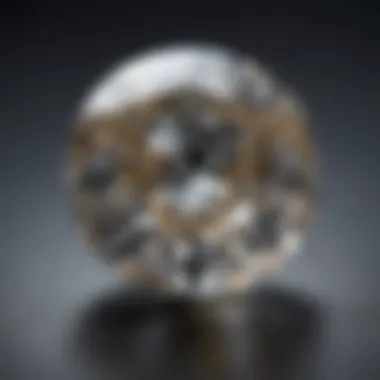
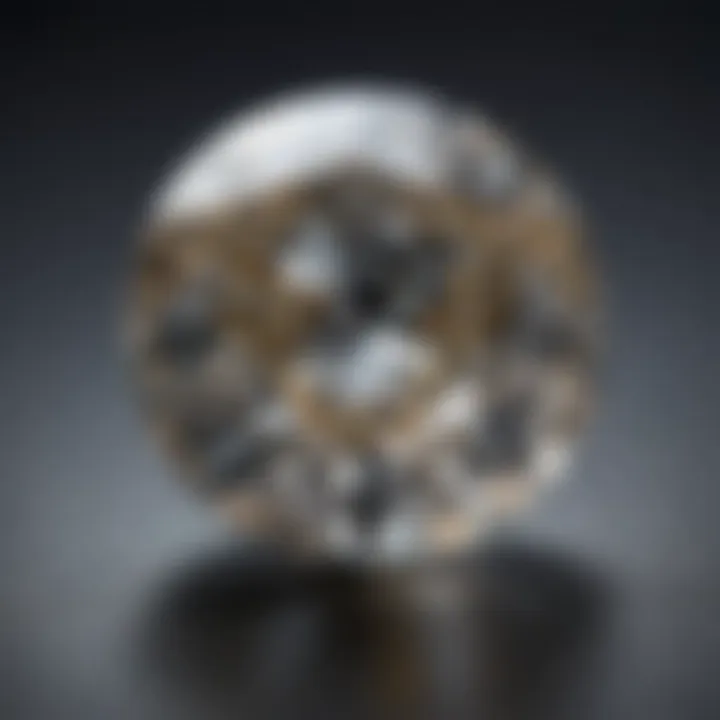
The i1 grading scale is a crucial element when diving into the realm of diamonds. Understanding this grade equips potential buyers with important knowledge that influences their choices. In general, the clarity grade of a diamond is vital as it defines the visible imperfections, which can affect both the aesthetics and the value of the stone.
This section explores the nuances of the i1 grade, illustrating its implications in terms of beauty and price, providing insights into what makes it distinct.
Explanation of the i1 Grade
The i1 grade stands for "Included 1" on the clarity scale used by gemological laboratories. In this context, it suggests that the diamond has noticeable inclusions. These flaws, while not invisible, can be overlooked by the naked eye under normal lighting conditions. What often comes into play here is how much these inclusions distract from the diamond's beauty.
An i1 diamond can have inclusions such as tiny fissures or black spots. Sometimes these features can actually add character to the stone, rendering it unique. Additionally, because i1 diamonds are less expensive than their higher-graded counterparts, they appeal to budget-conscious buyers who still want a genuine diamond experience. Importantly, when purchasing an i1 diamond, consumers should request a detailed examination or certification from a reputable gemological institution to ensure they understand what they are getting. Knowing the specifics about the clarity assists buyers in making informed decisions.
How i1 Diamonds Compare to Other Grades
When positioned against other clarity grades, i1 diamonds can appear a bit misunderstood. For instance, comparing them to the higher grades like VVS (Very Very Slightly Included) or VS (Very Slightly Included) reveals stark differences.
- VVS Grade: These gems contain almost no visible inclusions. They are considered excellent quality but come with a hefty price tag.
- VS Grade: These stones have minor inclusions that are difficult to detect without magnification. They still command a reasonably high price due to their clarity.
- i1 Grade: In contrast, as mentioned, these stones have notable inclusions visible to the naked eye. However, their affordability presents an attractive option for many.
"Understanding the clarity grade truly demystifies the choice between a price point and aesthetics when it comes to diamonds."
When considering an i1 diamond, buyers should balance their expectations of visual appeal with financial practicality. The eye of the beholder plays a significant role here, as one person may see beauty in the unique flaws while another may prioritize a flawless appearance.
The Aesthetics of i1 Diamonds
The aesthetics of i1 diamonds play a pivotal role in understanding their place in the jewelry market. While these stones might not be the epitome of clarity, they hold a different type of allure that can be appreciated through a distinct lens. Their visual qualities, often overlooked in favor of higher grades, possess their unique charm and appeal to specific buyers. This section illuminates the centrality of aesthetics in evaluating i1 diamonds, presenting an opportunity for enthusiasts to grasp how these diamonds can meet individual preferences in purchase decisions.
Visual Characteristics of i1 Diamonds
When it comes to i1 diamonds, the phrase "beauty lies in the eye of the beholder" rings particularly true. Unlike their higher-graded counterparts, these diamonds present some inclusions that can be visible to the observer without any magnification. However, many people find this to be part of their character.
- Unique Flaws: Some diamond lovers appreciate the unique inclusions and blemishes that make each i1 diamond one-of-a-kind. These variances give the stone individuality and a story of its own.
- Color: Often, the color spectrum of i1 diamonds displays a wide array of hues, with some presenting warm undertones that add softness to their appearance. A well-cut i1 diamond can exhibit a shimmering effect where the light is caught just right, often yielding mesmerizing displays.
- Cut Quality: A good cut can enhance the visual impact, even in the presence of inclusions. The way light interacts with the facets of the diamond can create eye-catching reflections, turning what might be seen as a deficit into a talking point.
These visual elements remind us that while clarity scores can guide our decisions, the attraction to a diamond's aesthetic can be subjective. In the hands of skilled designers, i1 diamonds are often featured in creative settings that help mask their imperfections, inviting onlookers to appreciate their overall look rather than obsessing over the small flaws.
The Effect of Clarity on Light Reflection
The clarity of a diamond, particularly in i1 grades, profoundly influences how light dances within it. In the world of gemstones, clarity doesn't merely dictate price; it impacts the aesthetic quality and the way diamonds shine. Here's a closer examination of the reflection dynamics in i1 diamonds:
- Light Interaction: In i1 diamonds, scattered inclusions can create a unique light reflection effect. While higher clarity diamonds scatter light uniformly, i1 diamonds may exhibit a more animated play of light due to their imperfections.
- Brilliance and Fire: Depending on how the diamond is cut, some i1 diamonds can project a decent amount of brilliance and fire, despite their clarity. The cut can enhance or subdue visible inclusions, allowing light to penetrate deeper into the stone and reflect more vividly.
- Personal Preference: Many collectors and enthusiasts argue that i1 diamonds hold an emotional connection that transcends clarity. They are often perceived as more authentic, reminding buyers that nature is not perfect, and neither is beauty.
"Inclusions tell a story that perfect clarity cannot; they mark each stone with fingerprints of nature, like a soft whisper between the earth and the gems we adore."
The aesthetics of i1 diamonds remind us that beauty is subjective, and not every eye will see flaws. For some, the specific characteristics of an i1 diamond are exactly what they desire, challenging conventional wisdom of what makes a diamond valuable.
Considerations for Buyers
When it comes to purchasing i1 carat diamonds, understanding key factors is vital. These diamonds, while more affordable, come with their own set of unique attributes and challenges. The importance of being informed cannot be overstated, especially for anyone looking to make a significant investment.
Evaluating Quality vs. Price
Many buyers find themselves weighing quality against price, particularly when it comes to i1 diamonds. Since i1 indicates inclusions that are noticeable at 10x magnification, some might perceive these stones as lower in value. However, a lower price tag doesn’t equate to poor quality, especially if the diamond still possesses good brilliance or color.
Buyers should consider how much clarity matters to them personally. Some may prioritize size over clarity, thereby allowing for a larger stone within their budget. Conversely, a buyer interested primarily in visual aesthetics might focus on isolation clarity. It’s wise to examine diamonds in person when possible to gauge their beauty firsthand rather than relying solely on grading.
Tips for Choosing the Right i1 Diamond
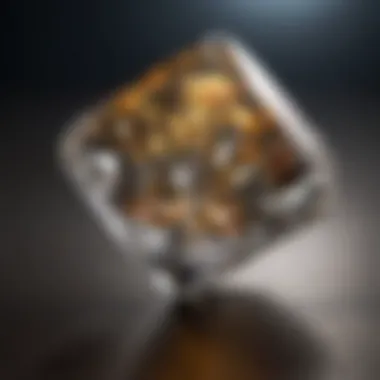
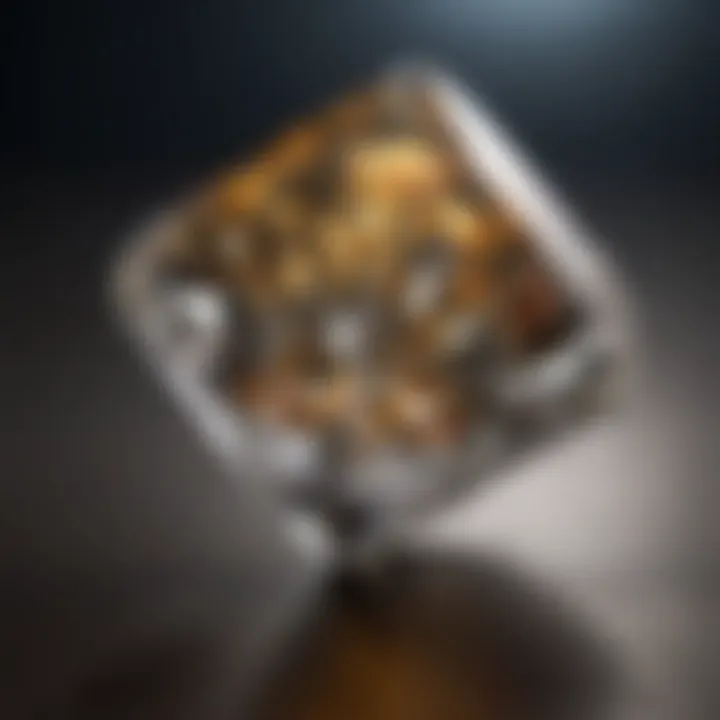
Selecting an i1 diamond can be akin to finding a needle in a haystack due to the myriad of options out there. Here are several pointers that may help streamline this process:
- Get Educated: Familiarize yourself with the 4 Cs (carat, color, clarity, and cut), and understand how they interact in an i1 diamond.
- Understand Lighting: Light can drastically change the appearance of a diamond. View the stone under different lighting conditions to get a true sense of its look.
- Seek Certified Stones: Aim for diamonds that come with certification from reputable institutions like GIA or AGS. That certification assures you of the diamond’s grading reliability.
"Being informed enables you to make a purchase that marries both beauty and value."
Where to Purchase Reliable i1 Diamonds
Finding reputable sources for purchasing i1 diamonds can influence your overall satisfaction with the purchase. Here are some avenues to consider:
- Local Jewelers: Visiting brick-and-mortar stores allows for a tactile experience, making it easier to compare diamonds directly and consult with experts.
- Reputable Online Retailers: Websites like James Allen or Blue Nile provide extensive inventory and detailed photos of each diamond. Ensure you read reviews and understand the return policy before placing an order.
- Auction Houses: For collectors or those seeking one-of-a-kind pieces, auction houses can sometimes provide rare i1 diamonds at competitive prices.
In summary, the considerations for buyers are multifaceted and require thoughtful deliberation. As you embark on this journey, remember to balance your personal preferences with market realities to make an informed decision.
Cultural Significance of Diamonds
Diamonds hold a unique place in human culture, transcending their physical properties to embody meanings that resonate deeply through time and across societies. The cultural significance of diamonds is multilayered, encompassing themes of status, love, and even historical narratives that shape our understanding of these precious stones. In this article, we will take a closer look at how diamonds—particularly i1 carat diamonds—are not merely aesthetic pieces but also bear great cultural and historical significance.
Historical Perspectives on Diamonds
Throughout history, diamonds have been revered as symbols of wealth and power. From the ancient civilizations to modernity, these gemstones have forged paths that intertwine with the cultural fabric of societies. For example, the Persian kings adorned their crowns with diamonds, believing these stones brought divine favor and protection. In fact, the term "diamond" itself comes from the Greek word "adamas," meaning unconquerable, a fitting title for a stone that has endured in esteem for centuries.
Among the tales that diamonds tell is that of the Koh-i-Noor, a legendary diamond of Indian origin. This stone has a tumultuous history filled with battles and shifting ownership, symbolizing both conquest and loss. People have documented its journey through various royal families, highlighting the diamond's role in affirming power and prestige. Such stories create an allure that continues to draw people toward diamonds today, providing a historical narrative that enhances their value.
Symbolism of Diamonds in Various Cultures
The symbolism associated with diamonds varies widely between cultures. In Western tradition, diamonds are chiefly recognized as the stone of love, prominently featured in engagement rings to symbolize commitment and fidelity. The phrase "diamonds are forever" resonates deeply here, portraying the notion that true love endures the test of time.
Conversely, in several Eastern cultures, diamonds carry differing connotations. For instance, in Indian tradition, diamonds are said to bring wealth and prosperity, often linked to astrological beliefs that suggest these stones can influence one's fate. They are worn not merely for beauty but also as talismans intended to attract auspicious energies.
In addition, diamonds also symbolize purity and indestructibility in many cultures. This is reflected in the phrase, "a diamond is a girl's best friend," which not only emphasizes the romantic charm of these gems but also their association with enduring beauty and strength.
"The value of a diamond lies not only in its brilliance but also in the stories it tells and the meanings it weaves into our lives."
Understanding these cultural contexts helps buyers appreciate i1 diamonds beyond their monetary value. As gemstones that hold historical tales and embody societal values, they become significant tokens of personal milestones, aspirations, and traditions.
In summary, the cultural significance of diamonds, particularly i1 carat diamonds, is far more profound than what meets the eye. They serve as potent symbols of various ideals—wealth, immense love, and eternal beauty—woven into the very fabric of human experience. As we explore further, it becomes clear that purchasing a diamond is not simply a transaction; it's an engagement with history and culture that enriches personal stories.
The Future of i1 Diamonds in Jewelry
The future trajectory of i1 diamonds reveals significant implications for the jewelry market, particularly as consumer preferences evolve. Understanding this future is essential for enthusiasts and collectors, as it influences both valuations and the overall aesthetic landscape of diamond jewelry. This section highlights key trends while shedding light on the benefits and considerations that come with them.
Current Trends in Diamond Usage
In recent years, there has been a noticeable shift in how different diamond grades are perceived and utilized in jewelry design. Greater emphasis is increasingly placed on personal expression rather than solely on traditional values associated with gemstones. Here are some evolving trends in diamonds:
- Sustainability and Ethical Sourcing: Consumers are drawing more towards ethically sourced diamonds. i1 diamonds, often more accessible due to their pricing, play a role in this growing movement. Buyers often appreciate the idea that they can enjoy elegant jewelry while supporting ethical practices.
- Customization and Personalization: Demand for bespoke jewelry pieces is rising. Jewelers are exploring ways to incorporate i1 diamonds into custom designs that do not sacrifice uniqueness or personal connection. Custom work opens the door to creativity, making i1 diamonds appealing options.
- Wearing Diamonds Beyond the Traditional: There is a current movement of wearing diamonds in more casual settings rather than just formal occasions. i1 diamonds bring a sense of style into everyday wear, which resonates well with millennial and Gen Z shoppers.
Projected Market Changes for i1 Diamonds
Looking forward, various factors could lead to substantial changes in the i1 diamond market. Tracking these potential shifts is vital for both buyers and sellers:
- Increased Acceptance of Lower Grades: As more individuals seek value without compromising on style, the acceptance of i1 diamonds may further deepen. With proper education about their unique characteristics, i1 diamonds are expected to gain more ground in mainstream diamond purchases.
- Technological Advancements in Treatment: Various methods are emerging to enhance the clarity of diamonds, including i1 stones. This could elevate their market positioning, transforming perceptions around their quality and desirability.
- Shifts in Investment Strategies: Investors are increasingly diversifying portfolios with alternative assets. This growing interest in non-traditional diamonds could lead to a more diversified buyer base for i1 diamonds, with some collectors viewing them as a solid investment choice due to their lower entry price compared to higher-graded diamonds.
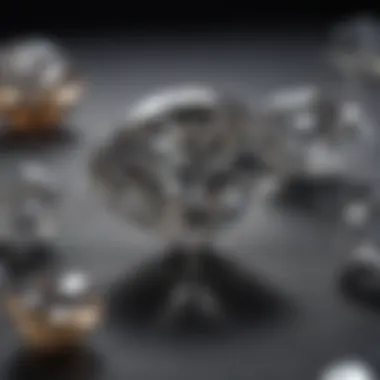
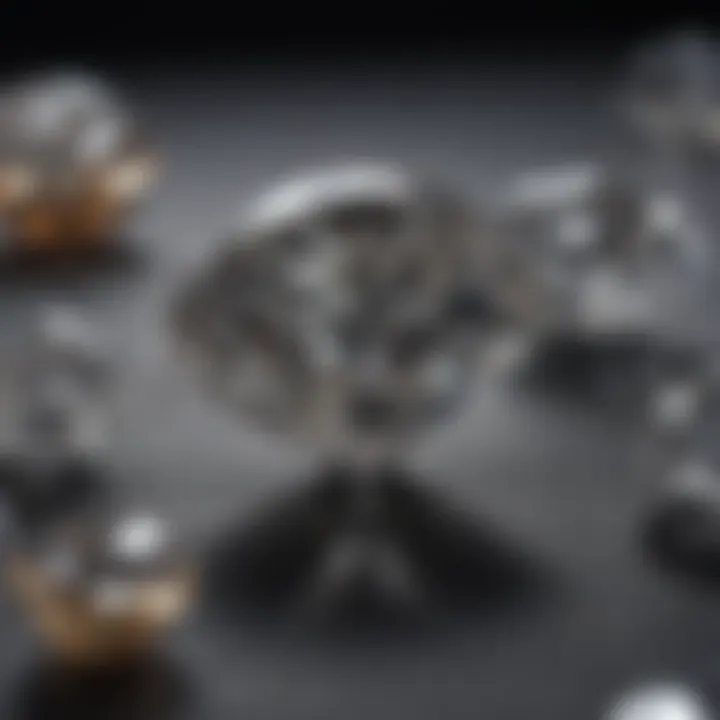
Understanding these trends not only speaks volumes about consumer habits but also positions i1 diamonds as an ever-growing presence within the jewelry market.
Investment Value of Diamonds
When it comes to the world of gemstones, diamonds have always held a prestigious place. For those looking at i1 carat diamonds, understanding their investment value is crucial. Unlike other investments, the allure of diamonds often lies in their beauty and rarity, not just their market value. It’s a nuanced situation where enthusiasts, collectors, and savvy investors converge. Evaluating the investment potential of these stones involves looking at a variety of factors—from market trends to individual characteristics of the diamonds themselves.
Investing in diamonds can be beneficial for diversifying portfolios, but the potential returns are as multifaceted as the gems themselves. When someone considers investing, they tend to weigh both the aesthetic appeal and resale potential. A diamond, especially an i1 grade, might appeal primarily due to its unique visual characteristics, yet its monetary value fluctuates based on the clarity grade, market demand, and global economic conditions.
Key elements to consider include:
- Market Trends: Understanding how the market for diamonds operates, particularly for i1 grades, is essential. These fluctuating trends can signal when is the best time to buy or sell.
- Clarity and Quality Assessment: Since an i1 diamond has significant inclusions, its appeal might lean more towards beauty rather than investment. Buyers should assess whether they are purchasing for personal enjoyment or investment reasons.
- Rarity and Unique Characteristics: Collectors may place value on the specific characteristics that make a diamond unique. This can elevate its standing in the investment market.
"Investing in diamonds isn’t just about capital; it’s about passion. Every stone tells a story and adds to its value over time."
Deciding how to include i1 diamonds in an investment portfolio is a matter of aligning personal investment goals with the unique qualities of each diamond.
Care and Maintenance of i1 Diamonds
Taking proper care of your i1 diamonds is more than just good practice; it significantly impacts the longevity and beauty of the gems. When you invest in diamonds, especially ones with an i1 clarity grade, ensuring they are well-maintained can help mitigate the visual imperfections that might be present. Routine care preserves their allure and maximizes your investment over time.
Cleaning i1 Diamonds Properly
Cleaning is an often-overlooked aspect of diamond care, yet it's essential to maintain their sparkle. i1 diamonds, with their clarity characteristics, can accumulate dirt and oils that may obscure their brilliance. Here's how you can clean these gems right:
- Gentle Soap Solution: Mix a few drops of mild dish soap with warm water. Soaking your diamond jewelry in this solution for about 10-15 minutes loosens grime.
- Soft-Bristle Brush: Use a soft-bristle toothbrush to gently scrub the diamond. Be cautious not to apply too much pressure, as this might scratch the stone. Focus on intricate settings where dirt is likely to gather.
- Rinse Thoroughly: After cleaning, rinse the diamond under warm running water to wash away any soap residue.
- Drying: Pat the diamond dry with a lint-free cloth to avoid lint buildup. Be careful to avoid paper towels, as they can scratch the surface.
Remember: Regular cleaning every month ensures that your diamonds remain visually appealing.
Storing i1 Diamonds Safely
Proper storage is key to maintaining the integrity of your diamonds. Storing them haphazardly can lead to scratches or other damage. Here’s how to keep your i1 diamonds safe:
- Separate Storage: Always store diamonds separately. Utilizing soft pouches or dedicated compartments in a jewelry box reduces the risk of scratching.
- Avoid Extreme Conditions: Extreme temperatures or humidity can affect the setting of your diamonds. Store them in a controlled environment, away from direct sunlight.
- Secure Locations: Use a safe or safety deposit box for valuable pieces. This is particularly important if you have multiple diamond pieces or when you are not wearing them for an extended period.
"The condition of a diamond often tells a story; taking the time to clean and store them properly ensures that the story remains bright and shining."
By adopting careful cleaning and storage habits, you'll not only enhance the beauty of your i1 diamonds but also protect your investment for years to come.
Eco-consciousness and Ethical Considerations
In recent years, awareness around the environmental and ethical implications of diamond mining has grown significantly. With globalization and easy access to information, consumers are becoming more cognizant of where their jewels come from. This recognition is particularly true for the diamond market. The focus on i1 carat diamonds, while significant in terms of visual aesthetics and pricing, must also consider the ethical narratives surrounding their procurement and sale.
Purchasing diamonds comes with a responsibility. The advantages of supporting ethically sourced diamonds extend beyond the personal satisfaction of making a conscious choice; it also influences the larger market dynamics within the jewelry industry. As buyers lean towards sustainable options, they encourage jewelers and suppliers to prioritize environmentally friendly and socially responsible practices.
Understanding Conflict Diamonds
Conflict diamonds, often referred to as blood diamonds, originate from areas experiencing war or civil unrest. These diamonds are mined under conditions that often exploit workers, fund violent conflicts, and lead to significant environmental degradation. The term raises alarms about the socio-economic repercussions tied to diamond extraction, affecting communities and nations alike.
It’s crucial to grasp that not all diamonds share this tainted background. Organizations such as the Kimberley Process aim to eliminate the trade of conflict diamonds by regulating their sale. However, gaps still exist, and industry practice varies widely. Many consumers, including those focused on i1 carat diamonds, now actively seek certifications and evidence of ethical sourcing before making a purchase.
"By being informed, buyers can contribute to a jewelry market that values human rights and environmental consciousness."
Promoting Sustainable Choices in Diamond Purchasing
When it comes to i1 diamonds, promoting sustainable choices in purchasing is more than just a trend; it's a movement toward a more ethical jewelry industry. Here are a few ways buyers can make informed decisions:
- Opt for Lab-Grown Diamonds: These stones have identical physical and chemical properties to natural diamonds but are created in a controlled environment. They offer a conflict-free alternative without compromising on clarity or beauty.
- Research Suppliers: Engaging with suppliers that are transparent about their sourcing practices is vital. Look for retailers who provide detailed information about where their diamonds are mined and how they’re processed.
- Consider Vintage or Second-Hand Options: Purchasing pre-owned diamonds not only reduces demand for new mining operations but also gives these gems a chance to shine again. It’s a sustainable choice that adds a touch of unique history to every piece.
- Advocate for Change: Consumers hold the power to influence market behavior. By supporting and promoting responsible practices, there can be a shift toward a more ethical diamond industry.
In summary, the considerations surrounding eco-consciousness and ethical implications are paramount when discussing i1 carat diamonds. Consumers have the ability to drive change through their purchasing decisions, supporting a sector that prioritizes human rights and environmental safeguards over mere aesthetics.



